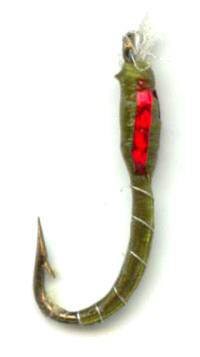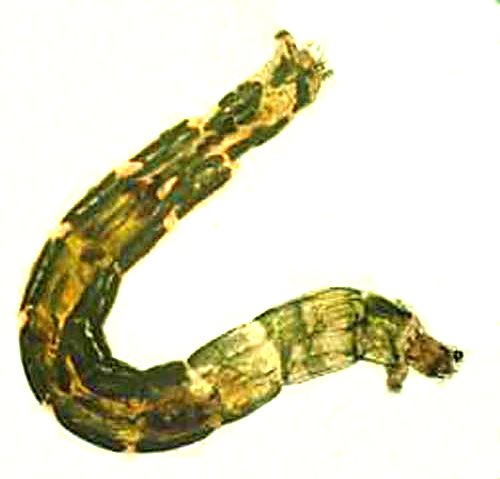Olive and Red Flash Epoxy Buzzer Midge Nymph
The olive and Red Flash epoxy buzzer midge nymph fly imitates the tiny Chironomid flies that inhabit lakes and slow-flowing rivers that are eaten by grayling and trout.

EPOXY BUZZER FLY PATTERNS. Hook size 12 14 16 18 20 24 - $US each
In lakes, reservoirs and slow moving water you will find midge larvae. They form a staple diet for grayling, rainbow and brown trout throughout the year. Use an olive and Red Flash epoxy buzzer midge fly pattern on a dropper as part of a team of three nymphs tied under a floating strike indicator or buoyant dry fly. Make the heaviest fly the point fly to keep the leader vertical. This olive epoxy buzzer fly pattern can also be used to imitate the crane fly larvae that is often found at the bottom of large lakes and reservoirs. I like to use a plummet to gauge the depth of the water. Do not buy one. Make one out of a lead weight and a marked line. Once I know how deep the water is I adjust the leader accordingly so that the point fly settles in the correct depth on every cast. If the trout start taking the droppers then this indicates that the fish are moving up away from the bottom to feed. Simply decrease the length of your leader so all you flies are fishing at the correct depth. If when you are casting the one of the buzzers are intercepted before the point fly has reached its correct depth then this will indicate that the fish have changed the depth at which they are fishing again (normally because of a change in water temperature or the weather). It is time to adjust the length of the leader to catch the fish feeding nearer the surface.

What about the theory that trout are quick to reject flies with a hard fell to them I hear some of you saying? Any nagging worries disappeared when I first used them on stillwater. I retrieved them extremely slowly, inched back, and these iron hard flies were taken with conviction. Generally black is the most effective color during the early season with olive more effective later on in the season. The buzzers tend to be larger in the warmer months so choose your hook size to match the natural insects. On the river fish a single buzzer nymph upstream using the tip of your fly line to register takes.
For beginners always learn to cast with a single fly tied on and only move on to a multi-fly rig having mastered your own casting technique. To achieve a balanced cast space your droppers evenly. If using flies of similar weight and size I try and space them evenly apart. If using flies of different weight and size I try to grade them with the heaviest on the point (end). Using two weighted flies can cause problems as they start pulling in their own direction causing snagging and problems when casting.
CUSTOMER'S COMMENTS
I had a fantastic one week holiday over Easter fishing Graftham Water in Cambridgeshire. The water has come to life with the improvement in water temperature due to the arrival of warm spring sunshine. The south shore particularly fished well. The trout were gouging themselves on the vast midge buzzer beds. Floating or midge-tip lines with your red flash olive or black epoxy buzzers, mainly straight lined were very productive. Tom Kennedy, Ely


